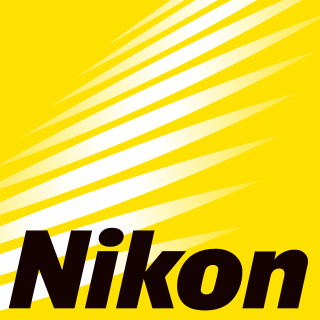
The Nikon 50 mm f/1.8D AF Nikkor is one of Nikon's 50 mm lenses. This Double-Gauss lens replaces the 50mm f/1.8 (non-D). A 50 mm prime lens is the normal lens for the 135 film format.
A kit lens is a "starter" lens which can be sold with an interchangeable-lens camera such as a single-lens reflex camera. It is generally an inexpensive lens priced at the lowest end of the manufacturer's range so as to not add much to a camera kit's price. The kit consists of the camera body, the lens, and various accessories usually necessary to get started in SLR photography. A kit lens can be sold by itself outside of a kit, particularly the ones that are moderately expensive; for instance a kit lens included in a prosumer SLR kit is often marketed as an upgrade lens for a consumer SLR. In addition, retailers often have promotions of standalone low-end SLR bodies without the lens, or a package that bundles the SLR body with one or two more expensive lenses.

The Nikon F-mount is a type of interchangeable lens mount developed by Nikon for its 35mm format single-lens reflex cameras. The F-mount was first introduced on the Nikon F camera in 1959, and features a three-lug bayonet mount with a 44 mm throat and a flange to focal plane distance of 46.5 mm. The company continues to use variations of the same lens mount specification for its film and digital SLR cameras.
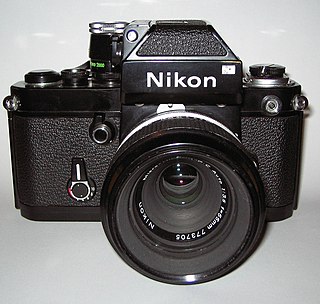
The Nikon F2 is a professional level, interchangeable lens, 35 mm film, single-lens reflex (SLR) camera. It was manufactured by the Japanese optics company Nippon Kogaku K. K. in Japan from September 1971 to 1980. It used a horizontal-travel focal plane shutter with titanium shutter curtains and a speed range of 1 to 1/2000 second plus Bulb and Time, and flash X-sync of 1/80th second. It had dimensions of 98 mm height, 152.5 mm width, 65 mm depth and 730 g weight. It was available in two colors: black with chrome trim and all black.
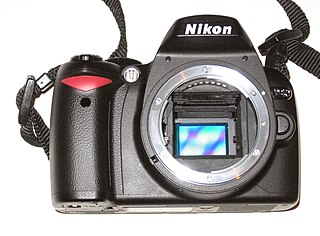
The Nikon DX format is an alternative name used by Nikon corporation for APS-C image sensor format being approximately 24x16 mm. Its dimensions are about 2⁄3 those of the 35mm format. The format was created by Nikon for its digital SLR cameras, many of which are equipped with DX-sized sensors. DX format is very similar in size to sensors from Pentax, Sony and other camera manufacturers. All are referred to as APS-C, including the slightly smaller Canon cameras.
The 17-35mm f/2.8D ED-IF AF-S Nikkor is an F-mount zoom lens manufactured and sold by Nikon. For 35mm format cameras, this lens covers a wide-angle range, and is well known as a photojournalists' lens. For Nikon DX format cameras, this lens covers a wide-to-normal range.
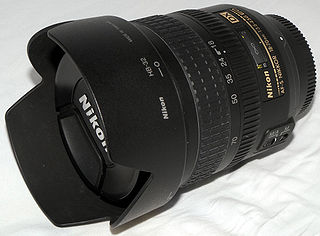
The AF-S DX Zoom-Nikkor 18-70mm f/3.5-4.5G ED-IF is an F-mount zoom lens manufactured and sold by Nikon. Designed exclusively for use on Nikon DX format cameras, this lens covers from wide-angle to medium-telephoto range.

Nikon has manufactured 10 different zoom lenses with a focal-length range of 70 to 200 mm range.
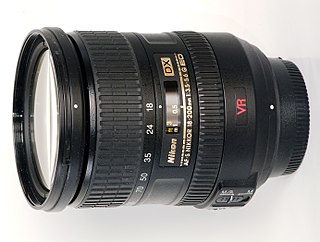
The Nikon AF-S DX VR Zoom-Nikkor 18-200mm f/3.5-5.6G IF-ED is an image stabilised superzoom lens manufactured by Nikon for use on Nikon DX format digital SLR cameras. It provides a single-lens "walk-around" solution for wide-angle through to telephoto shots, as well as close-up photography.
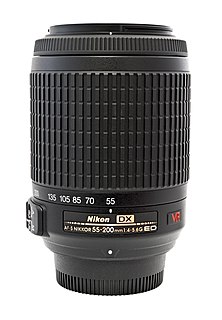
The 55-200mm AF-S lens is a medium telephoto zoom lens manufactured by Nikon for use on Nikon DX format digital SLR cameras. It comes in three variants:
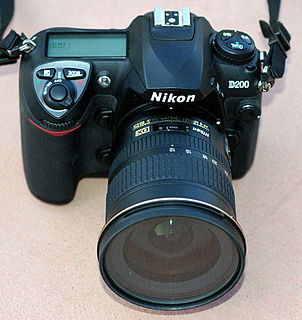
The AF-S DX Zoom-Nikkor 12-24mm f/4G is a lens manufactured by Nikon for use on Nikon DX format digital SLR cameras. It provides an angle of view on a DX format camera similar to that of an 18-35mm lens on a 135 film format camera.

The Nikon 1 series was a high-speed mirrorless interchangeable-lens cameras with 60 frames per second (fps) continuous shooting speed, using Nikon 1-mount lenses and announced on 21 September 2011. The series currently includes Nikon 1 V1, J1, J2, and S1 with a 10-megapixel image sensor, the V2, J3, S2 and AW1 with a 14-megapixel image sensor and further increased autofocus speed to 15 frames per second (fps), and the 1 V3, J4 with a new 18-megapixel image sensor, further increased — again world’s fastest — autofocus speed to 20 fps, 120 fps HD slow-motion at 1280 x 720 and 1080/60p. The J5 model added a 20.8MP sensor in 2015 and kept most other technical specifications the same as the J4 model.

The Nikon 1-mount is a type of interchangeable lens mount developed by Nikon for its Nikon CX format mirrorless interchangeable-lens cameras. The 1-mount was first introduced on the Nikon 1 series in 2011, and features a bayonet mount.

The Nikon 1 Nikkor VR 10-100 mm f/4.5-5.6 PD-Zoom for the 1 series' unique CX format is a Superzoom lens manufactured by Nikon, introduced in September 2011 for use on Nikon CX format mirrorless interchangeable-lens cameras.

The Nikon AF-S Zoom-Nikkor 24-120mm f/4G IF-ED VR is a 5x Standard zoom lens with a fixed maximum aperture of f/4 throughout its entire zoom range.
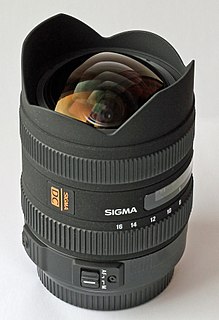
The Sigma 8–16mm lens is an enthusiast-level, ultra wide-angle rectilinear zoom lens made by Sigma Corporation specifically for use with APS-C small format digital SLRs. It is the first ultrawide rectilinear zoom lens with a minimum focal length of 8 mm, designed specifically for APS-C size image sensors. The lens was introduced at the February 2010 Photo Marketing Association International Convention and Trade Show. At its release it was the widest viewing angle focal length available commercially for APS-C cameras. It is part of Sigma's DC line of lenses, meaning it was designed to have an image circle tailored to work with APS-C format cameras. The lens has a constant length regardless of optical zoom and focus with inner lens tube elements responding to these parameters. The lens has hypersonic zoom autofocus.

The Nikon AF-S 17-55mm f/2.8 G IF-ED DX was announced in 2004. It is a F-mount professional zoom lens with a constant fast aperture of f/2.8 designed for Nikon DX digital SLR cameras. Nikon have incorporated their Silent Wave Motor for silent auto focusing. The lens is made mostly of metal and the rubber sealed rear mount makes the lens partially dust and water resistant. Dimensions of the lens are 85.5 x 110.5mm. The filter size is 77mm and the lens weighs 755g.

The AF-S DX Zoom-Nikkor 10-24mm f/3.5-4.5G ED is a lens manufactured by Nikon for use on Nikon DX format digital SLR cameras. It provides an angle of view on a DX format camera similar to that of a 15-35mm lens on a 135 film format camera.

